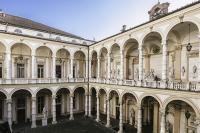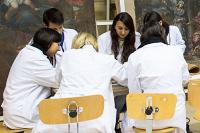Short history
The University of Turin was founded in 1404 by a papal Bull issued by Pope Benedict XIII. It then developed on the initiative of Prince Ludovico of Savoia-Acaja, who was willing to establish a University on his own land, at a crossroads between the Alps, Liguria and Lombardy.
The early decades were marked by interruptions caused by epidemics and crises that plagued the region; moreover there were difficult relationships between the University and the local administrative authorities, in fact between the 1420s and the 1430s Piedmont territories were annexed to the Duchy of Savoia. After a series of disruptions to its activities, the University was moved to Chieri (between 1427 and 1434) and later, in 1434, to Savigliano. In 1436, when the Institution returned to Turin, Ludovico of Savoia introduced a new order of studies, under which the Government gained greater control over the University.
In 1506 Erasmus of Rotterdam obtained his degree here. Indeed, many scholars, especially French and English, regarded Turin Studio as a first step in Italy before going on to older and better-known Universities.
From 1443 until 1720, the University was housed in a modest building purchased and refurbished for the purpose by the City on the corner of via Doragrossa (now via Garibaldi) and via dello Studio (today's via San Francesco d'Assisi) directly behind the Town Hall.
The inauguration of the prestigious building in via Po, close to piazza Castello, the centre of power and other educational institutions of the City, occurred in the academic year 1720-1721, which was also the first year of the University studies reforms enacted by Vittorio Amedeo II as part of a radical renewal of public administration and education at every level.
Vittorio Amedeo II was convinced that an efficient University, controlled directly by the State, was the only way to create a well-trained ruling class which could support him in the process of modernising the Nation. Among the notable innovations of the reform enacted by Vittorio Amedeo was the establishment of the Chair of Eloquenza Italiana (Italian Rhetoric) alongside that of Latin. This had a significant effect on the cultural linguistic standards of the Duchy.
In the 19th Century the University grew substantially to become one of the most prestigious Universities in Italy and a landmark for Italian Positivism, with teachers as Cesare Lombroso, Carlo Forlanini and Arturo Graf. In the Twentieth Century the University of Turin was one of the centre of Italian Antifascism.
Many of the leading figures in 20th century Italian political, social and cultural life, such as Antonio Gramsci and Piero Gobetti, Palmiro Togliatti and Massimo Bontempelli, Norberto Bobbio and Cesare Pavese, graduated from Turin University, as well as three Nobel Prizes for Medicine Winners, Salvatore Luria, Rita Levi Montalcini, Renato Dulbecco, and two Italian Republic Presidents, Luigi Einaudi and Giuseppe Saragat.
From 1st October 2019 the Rector of the University of Turin is Professor Stefano Geuna.






